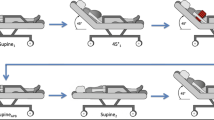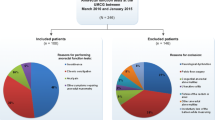Abstract
INTRODUCTION: Compliance is defined as the change in volume or cross-sectional area divided by the change in pressure. Pressure-volume measurement during distention with a compliant balloon is the most commonly used method for computation of rectal compliance. However, intraindividual and interindividual variations are large, restricting the usefulness of the method. Other methods such as rectal distention by a large, noncompliant bag and rectal impedance planimetry for assessment of pressure-cross-sectional-area relations have been proposed as alternatives owing to the reduction of errors from elongation of the balloon within the rectal lumen. However,in vivo reproducibility of pressure-volume measurement during distention with a compliant balloon, pressure-volume measurement during rectal distention by a large, noncompliant bag, and rectal impedance planimetry have never been compared. PURPOSE: The aim of this study was to comparein vivo reproducibility of the above-mentioned methods and to study theirin vitro reproducibility and validity. METHODS: Ten healthy volunteers (six men) aged 21–59 years were randomized to either rectal pressure-volume measurement with a compliant balloon or rectal impedance planimetry. After a one-hour rest, the other procedure was performed. After two weeks, both procedures were again performed in the same order. During rectal impedance planimetry the volume of the bag used (maximum volume 450 ml; secured at both ends to the probe) was continuously registered, measuring pressure-volume relations during rectal distention by a large, noncompliant bag. Reproducibility was tested by comparing the difference divided by the mean for each method at eight pressure steps in the range from 5 to 40 cm H2O. Furthermore, thein vitro reproducibility and validity of the three methods were studied using polyvinyl chloride tubes with known cross-sectional areas. RESULTS:In vivo reproducibility for pressure-volume measurement with a large, noncompliant bag and rectal impedance planimetry was significantly better than for pressure-volume measurement with a compliant balloon (P=0.005 andP=0.019, respectively). No statistically significant difference was found between pressure-volume measurement with a large, noncompliant bag and rectal impedance planimetry (P=0.20).In vitro reproducibility of pressure-volume measurement with a large, noncompliant bag and rectal impedance planimetry was good, but some elongation occurred, reducing the validity of pressure-volume measurement with a large, noncompliant bag. Coiling and elongation of the balloon within the lumen were major sources of error for pressure-volume measurement with a compliant balloon. CONCLUSION:In vivo andin vitro reproducibility of methods used for measurement of rectal compliance can be improved by restricting the effects of elongation within the lumen either by using a large-volume, noncompliant bag or by rectal impedance planimetry. However, pressure-volume measurement will to some degree depend on the properties of the balloons or bags.
Similar content being viewed by others
References
Kendall GP, Thompson DG, Day SJ, Lennard-Jones JE. Inter-and intraindividual variation in pressure-volume relations of the rectum in normal subjects and in patients with irritable bowel syndrome. Gut 1990;31:1062–8.
Åkervall S, Fasth S, Nordgren S, Oresland T, Hulten L. Rectal reservoir and sensory function studied by graded isobaric distension in normal man. Gut 1989;30:496–502.
Sørensen M, Rasmussen OØ, Tetzschner T, Christiansen J. Physiological variation in rectal compliance. Br J Surg 1992;79:1106–8.
Roe AM, Bartolo DC, Mortensen NJ. Diagnosis and surgical management of intractable constipation. Br J Surg 1986;73:854–61.
Suzuki H, Matsumoto K, Amano S, Fujioka M, Honzumi M. Anorectal pressure and rectal compliance after low anterior resection. Br J Surg 1980;67:655–7.
Toma TP, Zighelboim J, Phillips SF, Talley NJ. Methods for studying intestinal sensitivity and compliance: in vitro studies of balloons and a barostat. Neurogasteroenterol Motil 1996;8:19–28.
Sun WM, Read NW, Prior A, Daly J-A, Cheah SK, Grundy D. Sensory and motor responses to rectal distension vary according to rate and pattern of balloon inflation. Gasteroenterology 1990;99:1008–15.
Dal Lago A, Basilisco G, Mularczyk A, Saccheri S, Castagnone D, Bianchi PA. Magnetic resonance imaging of the rectum in resting condition and during distension [abstract]. Gastroenterology 1997;4:A718.
Madoff RD, Orrom WJ, Rothenberger DA, Goldberrg SM. Rectal compliance: a critical reappraisal. Int J Colorectal Dis 1990;5:37–40.
Rao GN, Drew PJ, Monson JR, Duthie GS. Incremental elastic modulus—a challenge to compliance. Int J Colorectal Dis 1997;12:33–6.
Gregersen H, Kassab G. Biomechanics of the gastrointestinal tract. Neurogasteroenterol Motil 1996;8:277–97.
Dall FH, Jørgensen CS, Houe D, Gregersen H, Djurhuus JC. Biomechanical wall properties of the human rectum. A study with impedance planimetry. Gut 1993;34:1581–6.
Whitehead WE, Delvaux M, and the Working Team of Glaxo-Wellcome Research, UK. Standardization of barostat procedures for testing smooth muscle tone and sensory thresholds in the gastrointestinal tract. Dig Dis Sci 1997;2:223–41.
Harris JH, Therkelsen EE, Zinner NR. Electrical measurement of ureteral flow. In: Boyarsky S, Tanagho EA, Gottschalk CW, Zimskind PD, eds. Urodynamics. London: Academic Press, 1971:465–72.
Gregersen H, Andersen MB. Impedance measuring system for quantification of cross-sectional area in the gastrointestinal tract. Med Biol Eng Comput 1991;29:108–10.
Duthie HL, Kee Kwong NG, Brown B. Adaptability of the anal canal to distension [abstract]. Br J Surg 1970;57:388.
Sun WM, Read NW, Donnelly TC. Anorectal function in incontinent patients with cerebrospinal disease. Gastroenterology 1990;99:1372–9.
Nordenbo AM, Andersen JR, Andersen JT. Disturbances of ano-rectal function in multiple sclerosis. J Neurol 1996;243:445–51.
Yeoh EK, Russo A, Botten R, et al. Acute effects of therapeutic irradiation for prostate carcinoma on anorectal function. Gut 1998;43:123–7.
Iwamoto T, Nakahara S, Mibu R, Hotokezaka M, Nakano H, Tanaka M. Effect of radiotherapy on anorectal function in patients with cervical cancer. Dis Colon Rectum 1997;40:693–7.
Varma JS, Smith AN, Busuttil A. Correlation of clinical and manometric abnormalities of rectal function following chronic radiation injury. Br J Surg 1985;72:875–8.
Prior A, Maxton DG, Whorwell PJ. Anorectal manometry in irritable bowel syndrome: differences between diarrhoea and constipation predominant subjects. Gut 1990;31:458–62.
Smith AN, Varma JS, Binnie NR, Papachrysostomou M. Disordered colorectal motility in intractable constipation following hysterectomy. Br J Surg 1990;77:1361–5.
Plusa SM, Charig JA, Balaji V, Watts A, Thompson MR. Physiological changes after Delorme's procedure for full-thickness rectal prolapse. Br J Surg 1995;82:1475–8.
Ryhammer AM, Laurberg S, Hermann AP. Test-retest repeatability of anorectal physiology tests in healthy volunteers. Dis Colon Rectum 1997;40:287–92.
Alstrup NI, Skjoldbye B, Rasmussen OØ, Christensen NE, Christiansen J. Rectal compliance determined by rectal endosonography: a new application of endosonography. Dis Colon Rectum 1995;38:32–6.
Author information
Authors and Affiliations
About this article
Cite this article
Krogh, K., Rhyhammer, A.M., Lundby, L. et al. Comparison of methods used for measurement of rectal compliance. Dis Colon Rectum 44, 199–206 (2001). https://doi.org/10.1007/BF02234293
Issue Date:
DOI: https://doi.org/10.1007/BF02234293




